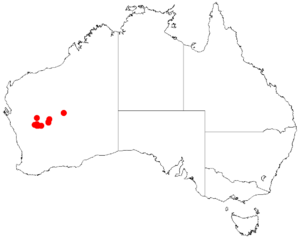Burrows’ snakewood facts for kids
Quick facts for kids Burrows’ snakewood |
|
|---|---|
| Conservation status | |
| Scientific classification | |
| Genus: |
Acacia
|
| Species: |
burrowsiana
|
 |
|
| Occurrence data from AVH | |
Acacia burrowsiana is a special tree. People also call it Burrows’ snakewood or gizzard wattle. It belongs to the Acacia family. This tree only grows in western Australia. This means it is endemic there, found nowhere else naturally.
What It Looks Like
This tree usually grows up to 5 meters (about 16 feet) tall. Its bark is grey and can be rough or cracked at the bottom. Higher up on the branches, the bark becomes smooth.
The trunk and main branches often look twisted and knotty. Its top branches spread out wide, like a flat crown.
Instead of regular leaves, Acacia burrowsiana has special parts called phyllodes. These are like flattened leaf stems that do the job of leaves. They are pale green and stand upright.
The phyllodes are long and narrow, shaped like a spear or an ellipse. They can be straight or slightly curved. Each one is about 7 to 13 centimeters (2.7 to 5 inches) long. They are also about 3 to 7 millimeters (0.1 to 0.2 inches) wide.
These phyllodes feel a bit stiff and have sharp points. They are smooth, meaning they have no hairs. You can also see parallel lines, or nerves, running along them.
The tree blooms between October and November. It produces simple flower spikes that are 10 to 20 millimeters (0.4 to 0.8 inches) long. These spikes are made of many flowers packed together.
Later, the tree grows seed pods. These pods look like a string of beads and are somewhat woody. They are curved or twisted in an irregular way. The pods are about 5 to 13 centimeters (2 to 5 inches) long and 5 to 7 millimeters (0.2 to 0.27 inches) wide. Inside, the seeds are brown to black and shaped like an ellipse.
Where It Grows
Acacia burrowsiana grows in different spots across the Mid West region of Western Australia. It is not found everywhere in one continuous area. Most of these trees are found around a town called Wiluna.
You can find this tree in flat areas along creeks and river beds. It also grows on breakaways (steep slopes) and on the tops of small hills. It prefers loamy soils mixed with ironstone gravel and stones. Sometimes, it grows in calcrete soils that have laterite and quartz.
A large part of the population lives in the Murchison region. This includes areas near Mount Magnet, Sandstone, and Cue.


